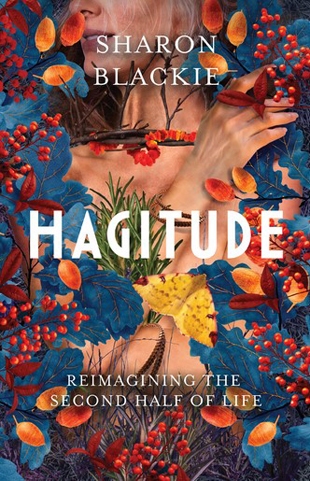Sharon Blackie writes beautifully. If she lives as beautifully as she writes — and the anecdotes in this book suggest this is true — I would like to know her. She tells us she just turned 60 while finishing this book and that she’s an aging woman. She coined the title word, “Hagitude,” to refer to an aging woman’s refusal to be silenced or invisible, adding, “The overculture would so like to pretend they’re not there.”
“I have no intention of being invisible,” she writes. “But I’m quite prepared to be inconvenient.”
Blackie fills these pages with stories from her native land — the islands of Britain and Ireland — including a great grandmother goddess, Cailleach, and other divine elder women. These stories are presented as archetypes and “remnants of pre-Christian cosmologies” that matter today for adults in the second half of life.
It depends what stories we tell, she explains, and most of the images we hold of aging women today are not healthy. This is a book first and foremost for woman over the age of 55. Blackie wants to reconnect you to the natural world, to life-giving goddesses (“no twinkly fairy queens”), to laughter, to argument, and to meaning.
Examples abound. “Our old women are the dark heart of the forest, the stone womb of the mountain, immanent in the living land itself. They’re elemental beings: storm hags, fire keepers, grandmothers of the sea.”
Topics explored include menopause (chapter 1) and elders (all of part 2).
We reread twice the chapter on beauty (chapter 3). The beauty she offers is what she calls “radical,” taking into account the full measure of a life. She writes, “There is some strange beauty in examining your own aging body and beginning to become properly acquainted with it. Beginning to take it seriously — beginning to listen to it, maybe even for the first time. Illness forces that on you, when nothing else will. A profound gratitude takes hold of you, as you acknowledge all the things it’s seen you through, as you begin to enumerate all the gifts it’s given you.” Then she enriches the chapter with stories from the journal of May Sarton, a novel of Doris Lessing, Georgia O’Keefe’s paintings, New Mexican poet Pat Mora, writer Penelope Lively, stories from her own life, and at least one “deliciously gruesome hag” of Irish folklore.
“The Dangerous Old Woman” is chapter 9, and this archetype, Blackie insists, represents those who are “carriers of the fire.” It is crafted around stories of Baba Yaga, a supernatural being in many Slavic mythic and folkloric traditions, depicted as a dangerous, frightening older woman. She busts any patriarchal system with wisdom that’s perilous and wild in the face of the status quo. A baba, in different Slavic languages, means midwife or sorceress, grandmother or fortune-teller. Blackie concludes: “I’m not entirely sure that Baba Yaga-type is an archetype we can become. But under the gaze of her discerning eye, we’re inspired to discover and to value the truth about ourselves.”
